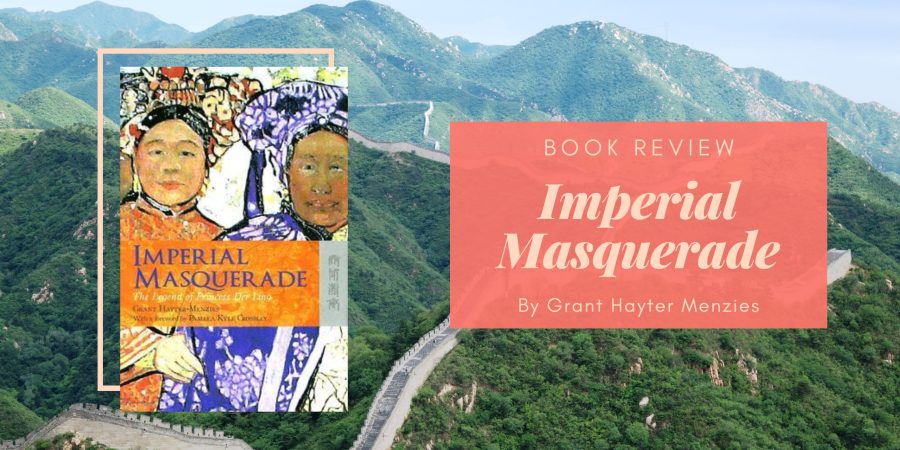After reading Two Years in the Forbidden City, I thought it was time to read about the woman who wrote the book, “Princess” Der Ling. Der Ling, who was also known as Elisabeth Antoinette White, was a fascinating woman. She claimed to be part of the Manchu ruling class, that she was fluent in multiple languages, and that she served in Cixi’s court and was not only a great favourite of hers, but was given the honorary title of “Princess” (which was never made official).
Currently, however, Der Ling is regarded as an unreliable source, and her works are frequently criticised. In Imperial Masquerade, Menzies combs through the sources by and about Der Ling and checks them against one another to create this biography of her. What we do know about her includes the following:
- Her father was probably not an ethnic Manchu, but one of the hanjun who served the Manchu and might have been from a non-Han Chinese ethnic minority group. Her mother, on the other hand, was half-Chinese and half-American, and her parents married for love.
- Der Ling did live overseas, in Japan and France, as her father was posted overseas on behalf of the Chinese court. That’s where she learnt both Japanese and French.
- While overseas, Der Ling met with a range of famous people, including Isabella Duncan, Countess Tokugawa (lady-in-waiting to the then-Empress Haruko), Sarah Bernhardt, and Pope Leo XIII
- Der Ling, her sister, and her mother did serve at Cixi’s court, probably because of their language skills
- Two Years in the Forbidden City was probably Der Ling’s most accurate book, the rest are less accurate. We also have to consider her motivations in writing; some of it was to refute the other books that were being published at that time.
While Menzies does not read Chinese, he has managed to access Chinese sources via translation and even manages to question them. For instance, he points out that some Chinese scholars may be reading translations of Der Ling’s works and given that she wrote them in English, it’s probable that the translations may not have been accurate. I was initially wondering how reliable the book was, but after reading through the text and the footnotes, it feels like a pretty good source on Der Ling.
The first half of the book, up until the point where Der Ling leaves the Chinese Court, is rather dry. It feels as though Menzies is merely fact-checking Der Ling’s claims. Where the book gets really interesting is in the last section and also in the footnotes. As Der Ling becomes a more contested figure, Menzies manages to tease out the possibility that the bias against her may be more than just academic. For all her faults, Der Ling did know the people she talk about, and the men who deemed her unreliable were frequently using other sources; one of them a forged diary (the Ching Shan diaries). I think that while we cannot take everything Der Ling says as the gospel truth, some of what she writes is accurate (particularly in Two Years in the Forbidden City and when it concerns her time at court). So how much of her currently discredited reputation is due to the fact that there were people who were pushing an anti-Cixi narrative and who had their own books to promote, which in turn created a reputation that persists till today?
If you decide to pick up this book, I highly recommend reading the footnotes as well. There’s quite a lot of content in here, and Menzies explains how he derived some of his information, or how he fact-checked Der Ling’s life against others who knew her or were in the same sphere as her (e.g. Katherine A. Carl, the artist who painted the first portrait of Cixi). It’s fascinating and I enjoyed it very much, especially when Menzies quotes from other sources.
Overall, this was a well-researched book about a fascinating woman. Der Ling is a woman who grappled with a very modern question: how can two different cultures (in this case, China and Western, specifically America) understand one another? I think it would be interesting to compare her life and works to that of another writer who also grappled with reconciling East and West – Endo Shusaku (Japan and Western culture). The two seem very different in character and their works are regarded very differently, but I think the issue they address is similar and it might be interesting to compare the both of them.
Incidentally, if you are interested in the Qing dynasty and you’re in Singapore, I’d like to invite you to come to the next Yaji event by Hanfugirl. We’ll be looking at the Qing dynasty and the question of identity; all of which are very relevant to Der Ling.
Featured Image: Photo from Canva

I really like that you read these two books so close together. It makes for an interesting study. I wondered if perhaps there was some reason behind the dispute that Der Ling’s work is true–who the critics are and what their motives may be definitely could play a part. I am glad to hear the footnotes are useful and worth reading. I often like to read footnotes, especially when they prove worthwhile.
Yes, it was very interesting! It may have been better if I could read the Chinese gossip papers; my friend was sending me some info from that and it seems like things reported there are slightly different too – looks like people saw many different things about her!
Okay but that cover is lovely!
Ack how did I not reply to your comment??? Sorry but yes, the cover is gorgeous!
Thanks for this review!
Thanks for writing this book on Der Ling! She’s really very fascinating and I’ve recommended your book to a few people who were keen to learn more about her!